Top 10 Patterns from Lake Erie
What got it done in the first Toyota Series Northern Division event of the year
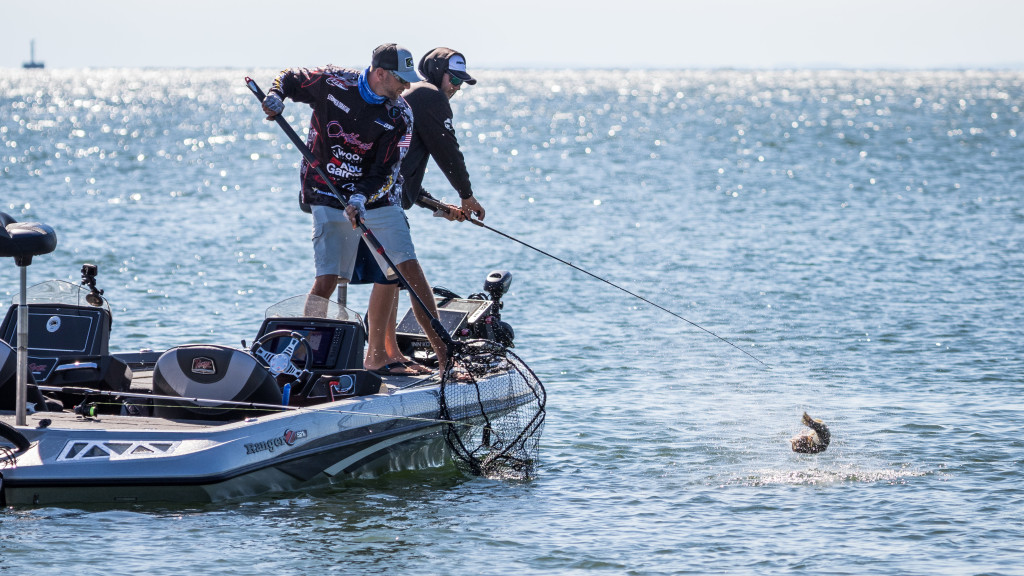
Lee Rogers mixed smallmouths from the nearby islands with a good largemouth day near Sandusky to win the Toyota Series Northern Division event on Lake Erie. Outside of Rogers, the top 10 was filled with folks making substantial runs eastward or to Michigan. It also proved helpful to actually get something going around Sandusky, both during days one and two and on the wind-hampered final day.

2. Sanford starts mixing in largemouths on day two
Drew Sanford weighed in 19 pounds of smallmouths on day one, but then ended up with less than 16 pounds each of the final two days to finish second.
On day one, Sanford ran east toward Vermilion, Penn., to catch his smallmouths on isolated rocks and rock piles in 18 to 20 feet. That pattern faded hard on day two, when he only managed to catch a couple fish deep and had to scramble, ending up with one shallow smallmouth in his bag and some green ones plucked from current around one of the many manmade channels in and around Sandusky Bay.
On the final day, Sanford caught the bulk of his weight around the current in the bay and off a few adjacent grass patches. Mostly fishing around a marina that had direct access to the main lake and the bay, Sanford used a Megabass Okashira Screw Head with a 3-inch Megabass Spark Shad to catch most of his fish.
Out in the lake, Sanford mostly used a drop-shot with a 1/4-ounce weight and a 3-inch Megabass Hazedong Shad. He also credited a T-H Marine Hydrowave that was mounted on the boat he borrowed for activating his smallmouths.
“One thing that was really weird is, in practice, I didn’t catch junk for the first half of the day,” explains Sanford. “I no more than turned that Hydrowave on, put it on “schooling fish” and started catching fish. I just tried it as a hope and a prayer, and I started catching fish. Before it was on, I didn’t see bass hardly at all. When I had it on, it looked like they went to the top of the rock. I used to have one, and I never could say yes that it worked or no it doesn’t, but after this week, I’ll have it on my next boat.”
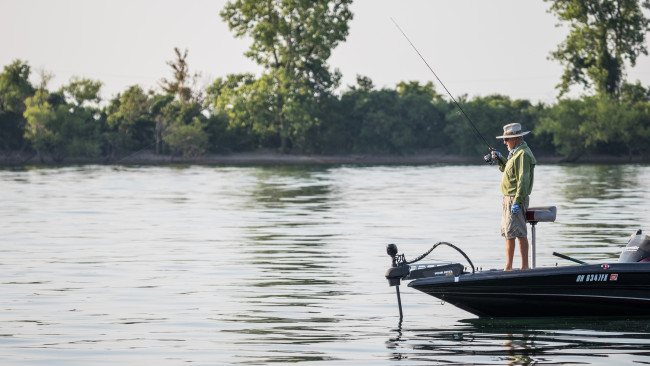
3. Bay day pays for Dawson
John Dawson put together two 16-pound bags fishing the islands in Erie, but he really made up ground on the final day fishing for largemouths.
Targeting rock in about 12 feet, Dawson stuck with a Ned rig for his smallies.
“We caught ‘em really good on day one,” says Dawson. “The second day was a lot tougher. I think we caught too many fish off that spot on day one. So, we scrambled, and we ended up putting a limit together. Really, the smallmouth for me wasn’t as good as they should have been.”
In the bay, Dawson went to work, catching what ended up being the second biggest bag of the day.
“I just started flipping pads, and I ended up with 15 pounds,” he adds. “I was pretty happy.”
Dawson’s big largemouth bag came flipping a 5-inch Yamamoto Senko in green pumpkin and gold flake. He Texas-rigged the Senko on 30-pound-test braid with a short 17-pound-test fluorocarbon leader and alternated between weights ranging from 1/8- to 3/4-ounce. He used the lighter 1/8-ounce weight in sparse pads and went up to a 1/2- or 3/4-ounce weight for the thick stuff.
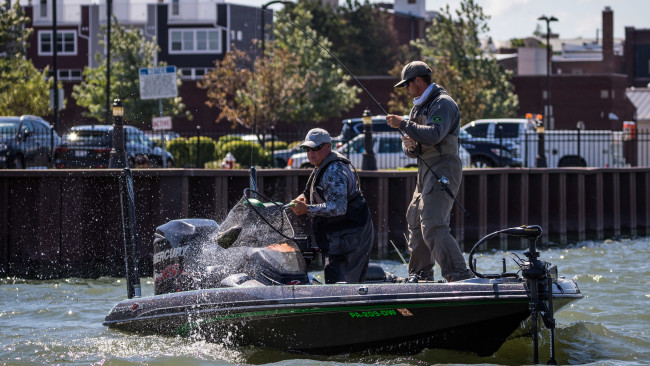
4. Kelley goes hard on the largemouths
Leaning into the largemouths was a point of curiosity pre-tournament, and Jonathan Kelley made it happen better than anyone else in the top 10.
“I had a really tough practice; it was one of the toughest practices I’ve ever had, and it’s a lake that usually produces really good weights,” says Kelley. “I made the decision to practice a fair amount in the bay, and it did pay off.
“Every day I started in the bay. On day one, I left with about 15 pounds, and that’s when I culled up to 17 pounds. On day two, it was a little tougher. I left with about 13 pounds, but I left an hour earlier.”
In the bay, Kelley plied a drop-shot and a jig.
“I fished a lot of the current areas,” says Kelley. “I had two or three rock piles that were just extended off the riprap, too. That’s how I caught a lot of my filler fish.”
On the lake, Kelley had a pair of rock piles on South Bass Island that topped out in about 8 feet where he caught some quality smallmouths – never more than three in a day, but still key fish to put him in the top 10.
For baits, Kelley plied a drop-shot with a 6-inch margarita mutilator Roboworm Straight Tail Worm and an X Zone Slammer in the bay and the lake, respectively, but his quality baits were a trio of jigs – a 1/2-ounce homemade football jig with a rubber skirt and a Zoom Speed Craw, a Keitech Model 1 Casting Jig with a Zoom Super Chunk and a Riot Baits Lil’ Creeper with a Yamamoto Double Tail Grub.
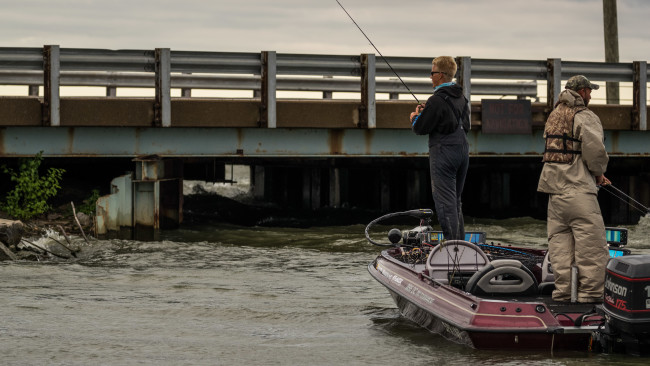
5. Largemouths play for Dietz
Like Sanford, Jonathan Dietz began mixing in his largemouths on day two.
“On the final day of practice, I found a little sweet spot,” says Dietz. “It’s flat slate rock that breaks up into big boulders. It was just an isolated spot that had a whole bunch of big ones on it.”
That little sweet spot produced a full limit of smallmouths on day one, but it faltered on day two. Then, he transitioned to the current bite in Sandusky Bay.
“It was around the bridges where you could see the current shooting through,” says Dietz. “I was just throwing around the high spots, which would concentrate the bass.”
On the final day, the water was muddier than it had been early in the week, making the current bite worse, so Dietz ended up catching most of his fish on a spinnerbait behind a protected marina wall.
On the lake, Dietz caught his fish on an elegy bone-colored Megabass Vision 110+1 and a Ned rig. He used the same jerkbait in the bay on day two, but in the Table Rock SP color.
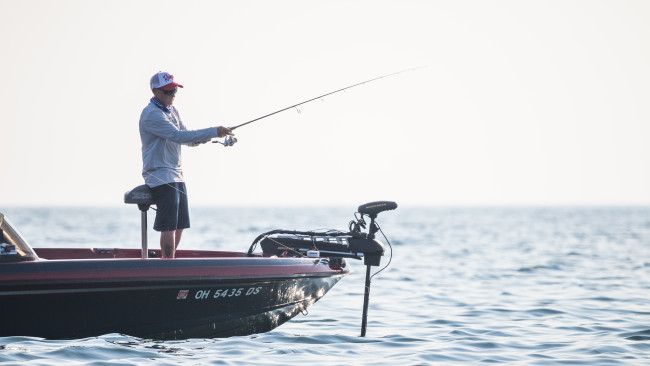
6. Eastward run works for Parker
Dick Parker lives in Lorain, Ohio, so where he ended smallmouth fishing wasn’t far from home. With the event coming up, he kept trying to find a reason to enter. Fishing current with a drop-shot was the deal on the final day, but he really made his money on days one and two. Then, he ran eastward to Vermillion for big smallmouths.
“I have thousands of spots there,” says Parker. “I was hitting everything from shallow to deep and I couldn’t find any fish. One night, I was just driving around, and I saw the bottom come up and I stopped. I dropped down and I caught one. That dialed me in.”
Parker ended up fishing a variety of breaks and rock piles with a drop-shot and a tube the first two days. His baits were a Poor Boy’s Erie Darter or a variety of Gulp! baits on a drop-shot and a Bass Pro Shops Tender Tube. For the tube, he used mostly a 3/8-ounce head, but upped it to 1/2 ounce in deeper water.
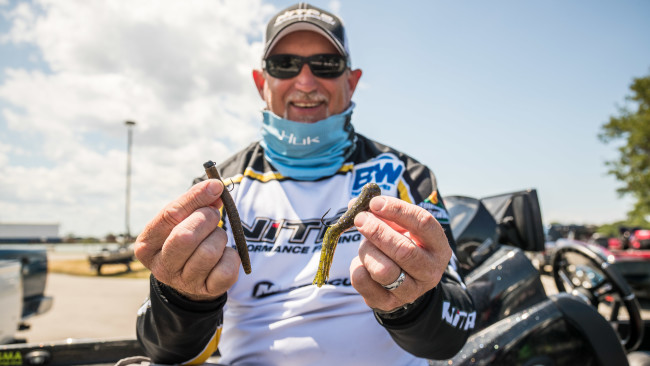
7. Slow and steady for Mitchell
Tony Mitchell did his best work on days one and two and tapped into something that was easily noticeable on the water – slow was the way to go for smallmouths.
“Days one and two, I ran out to Middle Bass Island and South Bass Island,” says Mitchell. “I fished real slow both days. I took my time. the bite wasn’t real fast and furious. I just milled around and took my time. The bait had to sit still for a long time was what I found.”
Fishing a 1/4-ounce Snack Daddy Lures Elite Tube and a Z-Man Big TRD on a 1/4-ounce Eco Pro Tungsten Shroom Head, Mitchell keyed on pretty shallow water.
“I was fishing spawning flats,” he says. “The fish were off the beds, but there were still a bunch roaming around. They were spread out pretty good, so you had to take your time. It probably took me about four hours to catch my limit both days.”
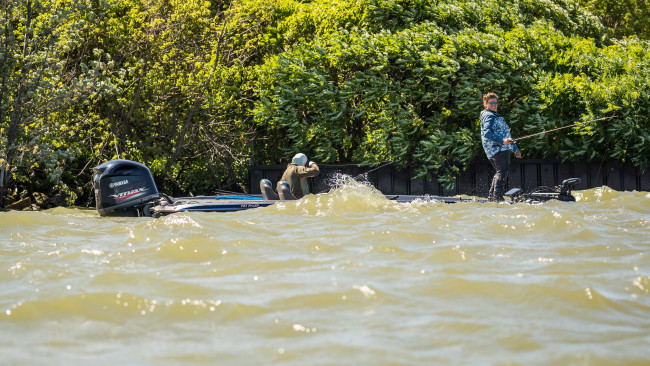
8. Long run pays off for Serafin
On days one and two, Chase Serafin ran to the Michigan waters of Lake Erie, near the mouth of the Detroit River.
“Most of the stuff I fished is pretty deep – like 22 feet off the edge and 18 feet on the top,” says Serafin. “In practice, I was able to drift stretches and catch a lot of big fish. Day one, it was so slicked off I couldn’t drift, and I think my biggest mistake was casting up on top of the rock piles too shallow. I spent too much time fishing on top, and my co-angler was fishing off the sides. On day two, I made some adjustments and I was able to drift more along the edges of the rock piles.”
At the mouth of the river, Serafin used a Duo Realis Spinbait 90 on the shallower stuff and a tube or a drop-shot with a Poor Boy’s Erie Darter deeper.
He chose the larger spy bait specifically because of the depths he was targeting.
“It’s a little bit bigger because I was fishing deeper water,” says Serafin of the Spinbait 90. “It’s easier to keep it down. For me at least, keeping it down is key; you’ve got to keep it down by the bottom. On a place like St. Clair, you always want to be ticking the grass and snapping it out of it.”
In the bay on the final day, Serafin struggled in the morning before switching over to cranking a rasta-colored Rapala DT6.
“I went back to my staple, to grinding rip rap walls with a crankbait,” says Serafin. “That worked. I was able to catch fish, and right at the end of the day I got lucky and got a big 5-pound smallmouth to bite and I lost it. It always hurts losing a 5-pounder.”
There are some pretty impressive photos of Serafin braving the waves while fishing, and he was doing it on purpose.
“What makes the difference here is fishing the points and rip rap that have the most wind and waves,” says Serafin. “It’s hard to keep your boat off it, but when you fish it, you get a lot more bites.”
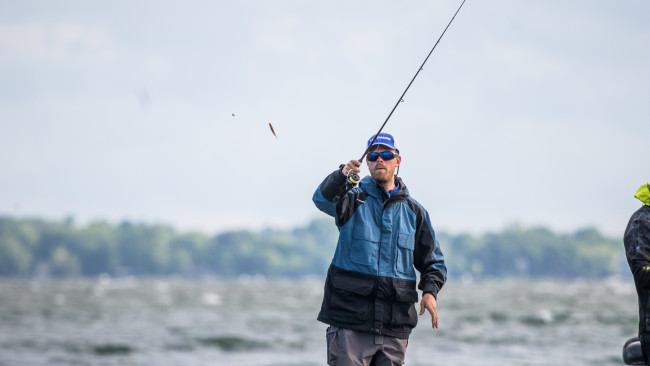
9. River run puts Stokes in position
Putting the hammer down and going to the Detroit River each day he was able, Troy Stokes put himself in first place after day two. It fell apart pretty hard on the final day, but his time in the river was still pretty excellent.
“They were on fire,” says Stokes. “We could have gone up there today and caught a limit in an hour. If we’d been allowed to go out today, and I thought I could have got there, 3 1/2 hours there and 3 1/2 hours back, I’d have done it.”
Fishing from as shallow as 3 feet to at deep as 18 feet, Stokes was fishing a variety of areas with heavy current. Though he used a spy bait some, his main weapon was a Poor Boy’s Erie Darter or anything that looked like a larger minnow on a drop-shot.
“They’ve been moving in, so the bite was a lot better there,” he says. “I didn’t even scratch the surface. We hit them pretty good, but I was keeping other areas and checking them every day.”
Stokes says he was fishing a few areas with sweet spots on them. While he wouldn’t pull up to a specific waypoint too often, he would know when he was most likely to get bit.
“One of the spots I didn’t even know about, I was just drifting with the current, and it wasn’t any bottom contour – it was just weeds, and there were a ton of fish sitting on the weeds and feeding,” says Stokes. “My main spot has got everything. It’s got weeds, it’s got stuff on the bottom, and a lot of current.”

10. Six drops to tenth
One of three pros unable to manage a limit on the final day, Drew Six was also making a long run the first two days, albeit to a different part of the lake than most.
Heading to Breast Bay, at the southwest corner of Lake Erie, Six caught over 16 pounds each of the first two days.
“Everything is waypoint-oriented,” says Six, who fished 40 to 50 waypoints a day. “Pull up to a rock, drop down, park it, wait 3 minutes and then pull up and one would be on it.
“I wanted to get away from the crowd. Being out of here, everyone was around the islands. Over there, I didn’t see another bass boat the entire two days.”
For his bait, Six used a Z-Man Scented Jerk ShadZ on a drop-shot.